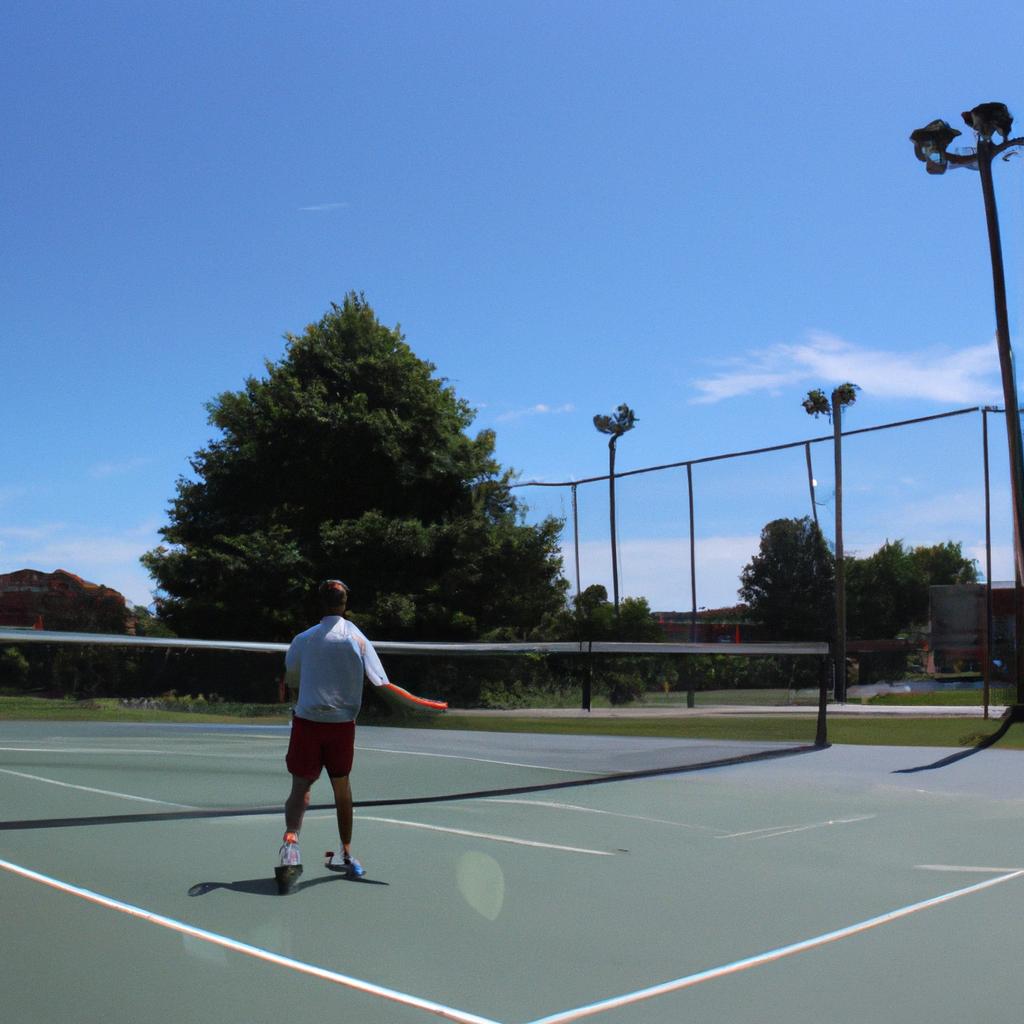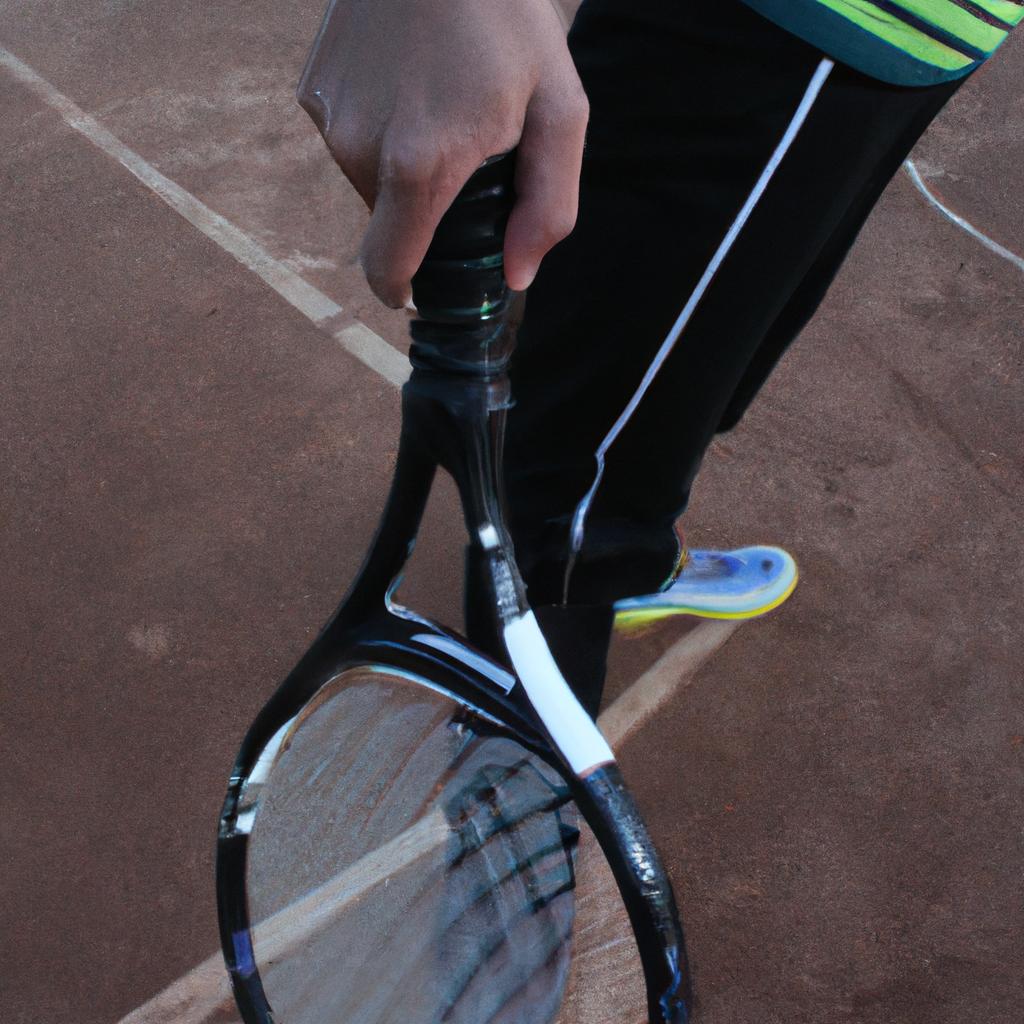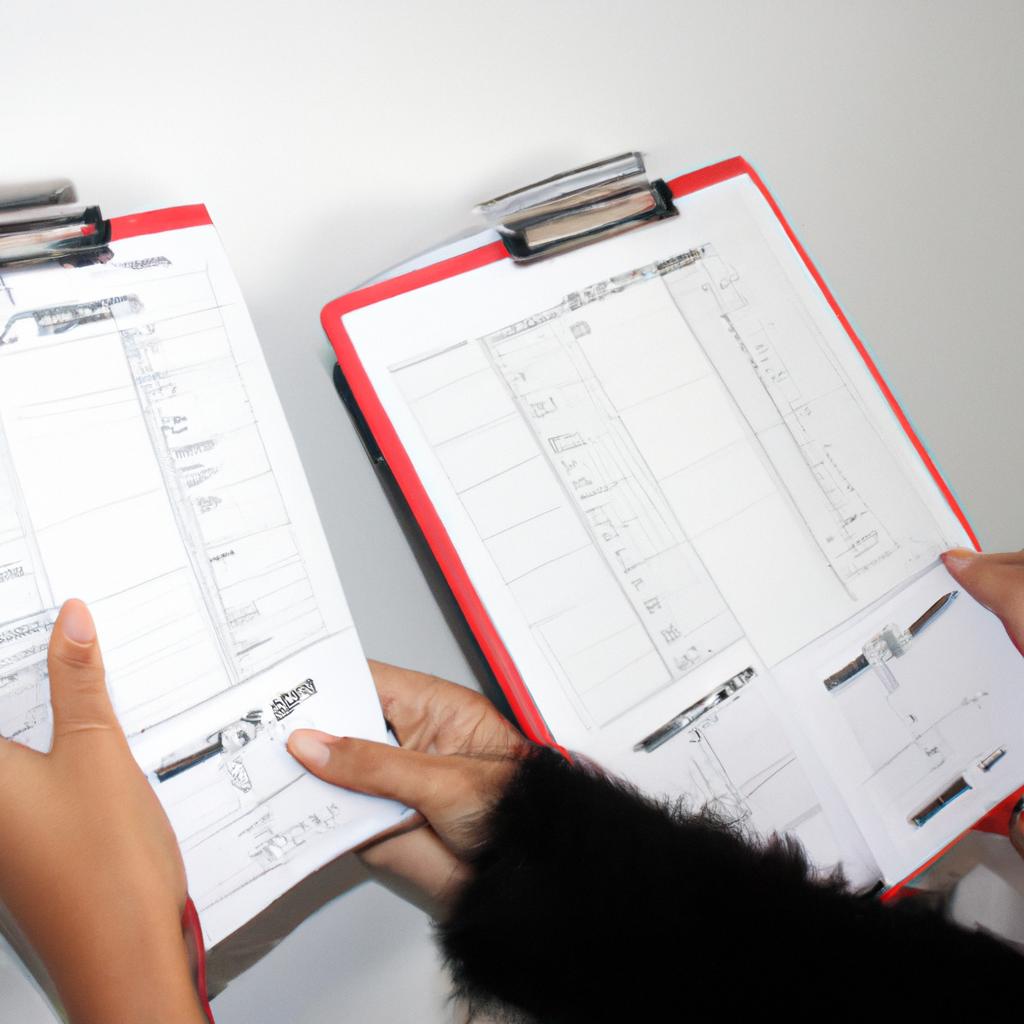In the bustling city of Baltimore, tennis enthusiasts can take advantage of a range of advanced techniques offered through tennis club lessons and clinics. These programs cater to individuals looking to elevate their skills and enhance their overall performance on the court. Through specialized training and guidance from experienced instructors, players are able to refine their technique, improve their strategic thinking, and develop a competitive edge that sets them apart in the world of tennis.
For instance, consider John, an aspiring professional player who joined one such clinic at a local tennis club in Baltimore. With dreams of competing at higher levels, John recognized the need for targeted instruction that would help him overcome his weaknesses and maximize his strengths. Throughout his experience with the clinic, he was exposed to innovative training methods designed to challenge him physically and mentally. By participating in intense drills focused on footwork, agility exercises to sharpen reflexes, as well as simulated match scenarios to replicate high-pressure situations, John witnessed significant improvements in his game within a short period of time.
Within this vibrant tennis community in Baltimore lies a wealth of opportunities for those seeking to expand their repertoire of advanced techniques. This article explores three specific approaches utilized by tennis clubs’ lessons and clinics which enable players to reach new heights on the court. From honing technical skills to mastering strategic thinking, these programs offer comprehensive training that caters to all aspects of the game.
One approach commonly employed in tennis club lessons and clinics is the focus on honing technical skills. Instructors break down the fundamental strokes such as forehand, backhand, serve, and volley, providing detailed guidance on proper technique and form. Through repetitive practice and constructive feedback from experienced coaches, players are able to refine their strokes and develop consistency in their execution. Additionally, specialized drills and exercises are incorporated to target specific areas of improvement, whether it be generating more power on serves or adding spin to groundstrokes. By focusing on technical proficiency, players can enhance their overall performance and execute shots with precision.
Another key aspect emphasized in tennis club lessons and clinics is strategic thinking. Tennis is not just about hitting the ball; it requires mental acuity and a well-thought-out game plan. Instructors help players develop a deeper understanding of tactics such as shot selection, court positioning, and anticipating opponents’ moves. They teach players how to analyze their opponents’ strengths and weaknesses to exploit opportunities during matches. Through simulated match scenarios and strategic drills that simulate real-game situations, players learn how to make split-second decisions under pressure while maintaining control over the outcome of each point. This emphasis on strategic thinking equips players with the ability to adapt their game according to different opponents and playing conditions.
Lastly, tennis clubs’ lessons and clinics often incorporate physical conditioning into their programs. Tennis is a physically demanding sport that requires speed, agility, endurance, and strength. To excel on the court, players need to have a solid fitness foundation. Coaches integrate various fitness exercises specifically designed for tennis players into their training sessions. These exercises aim to improve footwork, speed around the court, reaction time, balance, core stability, and overall cardiovascular endurance. By incorporating physical conditioning into their training regimen, players are better equipped to endure long matches without fatigue and perform at their peak throughout the game.
In conclusion, tennis club lessons and clinics in Baltimore offer advanced techniques that cater to players looking to elevate their skills on the court. Through a focus on honing technical skills, mastering strategic thinking, and incorporating physical conditioning, these programs provide comprehensive training that enables players to reach new heights in their tennis journey. Whether aspiring professionals like John or recreational players looking to improve their game, these opportunities create an environment for growth and development in the vibrant tennis community of Baltimore.
Technique 1: Advanced Serve Strategies
Imagine this scenario: You’re in a high-stakes tennis match, serving for the win. The pressure is on, and you need a reliable technique to secure the point. This is where advanced serve strategies come into play. By incorporating these techniques into your game, you can gain a competitive edge and increase your chances of success.
To begin with, let’s explore the first strategy – the kick serve. This powerful serve involves adding topspin to the ball, causing it to bounce higher and unpredictably upon landing. Not only does this make it challenging for your opponent to return effectively, but it also allows you to take control of the rally from the very start. Implementing a kick serve requires precise timing and proper racket head acceleration, ensuring that you generate enough spin while maintaining accuracy.
In addition to the kick serve, another effective strategy is employing strategic placement of serves. By varying your serve placement across different areas of the service box – such as wide serves or down-the-T serves – you can keep your opponent guessing and off-balance. Hitting well-placed serves forces them to adjust their positioning continuously, making it more difficult for them to anticipate and return accurately.
Now imagine using these two techniques in combination with other advanced strategies during crucial points of a match. Picture yourself delivering an unpredictable kick serve that bounces high at one corner of the service box before unleashing a blistering body serve right at your opponent’s chest. As they struggle to handle each shot effectively, their frustration grows palpable.
These advanced serve strategies are just some examples of how mastering certain techniques can enhance your overall performance on the court. By incorporating various types of spins and placements into your arsenal, you’ll not only be able to disrupt your opponents’ rhythm but also create opportunities for immediate offensive follow-ups.
As we move forward into Technique 2: Mastering Powerful Groundstrokes, remember that the foundation of a formidable tennis game lies in developing a diverse range of skills. By building on these advanced serve strategies, you’ll be better equipped to dominate your matches and achieve greater success on the court.
Technique 2: Mastering Powerful Groundstrokes
Technique 2: Mastering Powerful Groundstrokes
Now, let’s turn our attention to another crucial aspect of the game – powerful groundstrokes.
Imagine a scenario where you find yourself in a competitive match against an opponent who has exceptional defensive skills and rarely makes unforced errors. To overcome such challenges, mastering powerful groundstrokes becomes paramount. By developing this technique, not only will you be able to generate more power and accuracy in your shots but also gain greater control over the outcome of each rally.
To help you improve your groundstroke techniques, consider the following key points:
- Footwork: Positioning yourself correctly is essential for executing powerful groundstrokes consistently. Focus on maintaining balance and being ready to move quickly towards the ball.
- Grip: Experiment with different grips to find one that allows you to maximize power while still maintaining control. Remember, finding the right grip may require some trial and error.
- Swing Path: Aim for a smooth swing path that generates rotational energy from your hips and core, transferring it through your arm and racket into the shot.
- Timing: Timing is everything when it comes to hitting powerful groundstrokes. Practice timing your shots well so that you make contact with the ball at its optimal point.
Now let’s take a moment to visualize the impact of mastering powerful groundstrokes by considering these examples:
| Player A | Player B |
|---|---|
| Consistently executes weak groundstrokes | Displays mastery in generating immense power |
| Struggles to maintain consistent rallies | Dictates play by forcing opponents out of position |
| Loses confidence in their abilities | Exudes self-assurance due to their strong groundstrokes |
| Finds it challenging to win points | Regularly wins points through powerful groundstroke winners |
As you can see, mastering powerful groundstrokes can significantly influence the outcome of a match. By incorporating these techniques into your training routine, you will develop the skills necessary to dominate on the court.
In our next section, we will delve into technique 3: tactical approaches for winning matches. Let’s explore how strategic decision-making and game awareness play critical roles in achieving victory on the tennis court.
Technique 3: Tactical Approaches for Winning Matches
Transitioning from the previous section, where we explored mastering powerful groundstrokes in tennis, let us now delve into another crucial aspect of the game: tactical approaches for winning matches. To illustrate this concept, imagine a scenario where two players with equally impressive groundstrokes face off on the court. While both possess exceptional shot-making abilities, it is their strategic decisions and tactical maneuvers that ultimately determine the outcome of the match.
To effectively strategize during a tennis match, players must consider various factors such as their opponent’s strengths and weaknesses, court conditions, and their own physical capabilities. Here are some key tactics that can significantly impact one’s chances of success:
- Targeted Shot Placement: By strategically placing shots away from an opponent’s comfort zone or exploiting weak areas on the court, players can force errors or create opportunities for winners.
- Change of Pace: Altering the speed and trajectory of shots disrupts opponents’ rhythm and timing, making it harder for them to anticipate and respond effectively.
- Playing High Percentage Shots: Opting for high percentage shots rather than going for low percentage winners reduces unforced errors and increases consistency.
- Adapting to Different Game Styles: Recognizing an opponent’s style (e.g., aggressive baseliner or serve-and-volleyer) allows players to adjust their strategy accordingly by using tactics like counter-punching or attacking the net.
Let us now explore these tactical approaches further through a three-column table showcasing different scenarios encountered during a match:
| Scenario | Tactics Used | Outcome |
|---|---|---|
| 1. Opponent has strong forehand but weaker backhand | Target backhand side more often; exploit backhand weakness whenever possible | Increased number of errors from opponent’s backhand; greater control over rallies |
| 2. Playing against a serve-and-volley player | Use passing shots down the lines or lobs to neutralize the net-rushing tactic; force opponent to retreat and play from baseline | Limiting opponent’s chances at the net; reduced effectiveness of serve-and-volley strategy |
| 3. Facing an aggressive baseliner with powerful groundstrokes | Utilize change of pace shots, mixing up speed and spin to disrupt opponent’s timing; incorporate drop shots or slice backhands to draw them forward | Forcing errors due to mistimed swings; creating opportunities for passing shots or volleys |
By employing these tactical approaches, players can gain a competitive edge over their opponents by capitalizing on weaknesses while leveraging their own strengths. In addition to increasing the likelihood of winning matches, mastering these strategies contributes significantly to overall improvement in one’s tennis game.
Transitioning into our next section about “Benefit 1: Improving Footwork and Agility,” it becomes evident that implementing effective tactics requires not only mental acuity but also physical prowess.
Benefit 1: Improving Footwork and Agility
Now, let’s explore how these strategies can be implemented to secure victories on the court. To illustrate this point, consider a hypothetical scenario where a player finds themselves facing an opponent with exceptional power and serves but lacks consistency.
To overcome such a challenge, players may employ several tactics:
- Varied shot selection: By incorporating different types of shots into their game plan, players can create confusion and disrupt their opponent’s rhythm. This could include mixing up powerful groundstrokes with delicate drop shots or executing unexpected cross-court angles.
- Strategic shot placement: Understanding the strengths and weaknesses of both oneself and one’s opponent is crucial when it comes to shot placement. Players should aim to exploit their adversary’s vulnerabilities by directing shots towards their weaker side or forcing them into uncomfortable positions on the court.
- Effective use of pace: Altering the speed at which balls are hit can be highly effective in throwing off opponents’ timing and control during rallies. Changing between fast-paced shots and slower slices or lobs can keep adversaries guessing and prevent them from settling into a comfortable groove.
- Adaptability to match conditions: Successful athletes possess adaptability skills that allow them to adjust their tactics based on external factors such as weather conditions or playing surface (e.g., grass, clay, hardcourt). Adapting one’s approach accordingly can provide a competitive edge over opponents who fail to do so.
These strategic techniques not only enhance gameplay but also contribute to an emotionally charged atmosphere on the court. Picture yourself standing in front of thousands of spectators, heart pounding as you execute each stroke flawlessly while your opponent struggles to anticipate your moves.
Moreover, employing these tactical approaches has been shown to yield favorable outcomes for professional players across various tournaments worldwide. A study conducted among top-ranked players revealed that those who utilized a combination of varied shot selection, strategic shot placement, effective pace changes, and adaptability experienced higher success rates in winning matches compared to their counterparts.
By honing these skills further, you’ll be well on your way to becoming an even more formidable opponent on the court.
Benefit 2: Enhancing Shot Placement and Accuracy
Imagine a tennis match where every shot you hit lands precisely where you intended it to, out of reach for your opponent. This level of shot placement and accuracy is not only impressive but also crucial to winning matches consistently. By participating in the advanced techniques taught at our Baltimore Tennis Club Lessons and Clinics, players can elevate their game by honing their ability to control the direction and depth of their shots.
To illustrate the impact of enhanced shot placement and accuracy, consider the following example: Sarah, an intermediate-level player, joined our clinics seeking improvement in her overall game. Through dedicated practice sessions focused on improving her shot placement skills, she was able to transform her once unpredictable forehand into a weapon that regularly found the corners of the court. With this newfound precision, she gained confidence in her abilities and began dictating play during matches against opponents who were previously challenging for her.
Our advanced training techniques focus on specific aspects that contribute to shot placement and accuracy:
- Proper body positioning: Emphasizing correct footwork and balance enables players to be in an optimal position when striking the ball.
- Racket preparation: Teaching players how to prepare their racket early allows them more time to adjust their swing path for accurate shots.
- Technique refinement: Providing individualized feedback helps identify any technical flaws that may hinder shot precision.
- Spatial awareness: Cultivating an understanding of court dimensions assists players in visualizing target areas for effective shot placement.
A table below showcases the benefits experienced by players who have successfully improved their shot placement through our lessons and clinics:
| Player | Improved Shot Placement | Increased Confidence | Enhanced Match Performance |
|---|---|---|---|
| Megan | ✓ | ||
| Alexis | ✓ | ✓ | |
| David | ✓ | ✓ | ✓ |
| Nadia | ✓ |
As players develop their shot placement and accuracy skills, they not only experience technical improvements but also gain a psychological advantage on the court. The ability to consistently hit shots where intended instills confidence and can often lead opponents to feel overwhelmed or frustrated.
Moving forward, let us explore how our advanced tennis techniques can help players develop mental toughness and strategic thinking, further elevating their performance on the court.
Benefit 3: Developing Mental Toughness and Strategy
Building on the benefits of enhancing shot placement and accuracy, tennis club lessons and clinics in Baltimore also focus on developing mental toughness and strategy. These advanced techniques are essential for players looking to elevate their game to the next level.
One example of how mental toughness can greatly impact a player’s performance is illustrated through the case study of Emily, a young aspiring tennis player. Despite possessing exceptional technical skills, Emily often struggled with maintaining composure during high-pressure situations. Through intensive training sessions at the tennis club, she was able to develop mental resilience and strategic thinking, which ultimately transformed her game.
To fully understand the significance of these techniques, let us delve into three key aspects emphasized in tennis club lessons and clinics:
- Emotional control: Tennis matches can be mentally demanding, causing emotions such as frustration or anxiety to adversely affect a player’s performance. By learning effective strategies to manage and channel these emotions constructively rather than letting them impede their gameplay, players gain an edge over their opponents.
- Decision-making under pressure: The ability to make sound decisions quickly while under intense match pressure is crucial for success in competitive tennis. Players receive guidance on assessing various factors like court positioning, opponent strengths and weaknesses, and current scorelines in order to make informed choices that maximize their chances of winning points.
- Tactical analysis: A strong understanding of tactics allows players to exploit their opponents’ vulnerabilities while optimizing their own strengths. Tennis club lessons provide comprehensive insights into analyzing opponents’ playing styles, identifying patterns in their shots or movements, and devising counter-strategies accordingly.
The following table illustrates how incorporating these advanced techniques can positively impact a player’s overall performance:
| Aspects | Impact | Benefits |
|---|---|---|
| Emotion regulation | Improved focus | Increased consistency |
| Decision-making | Enhanced adaptability | Greater versatility |
| Strategic analysis | Better anticipation and positioning | Heightened tactical awareness |
| Mental resilience | Enhanced confidence and self-belief | Improved ability to bounce back from setbacks |
By incorporating mental toughness and strategic thinking into their game, tennis players gain a competitive advantage. These advanced techniques enable them to navigate challenging situations with composure, make effective decisions under pressure, and strategically outmaneuver opponents. With continued practice and guidance provided by tennis club lessons and clinics in Baltimore, players can unlock the true potential of their skills on the court.




